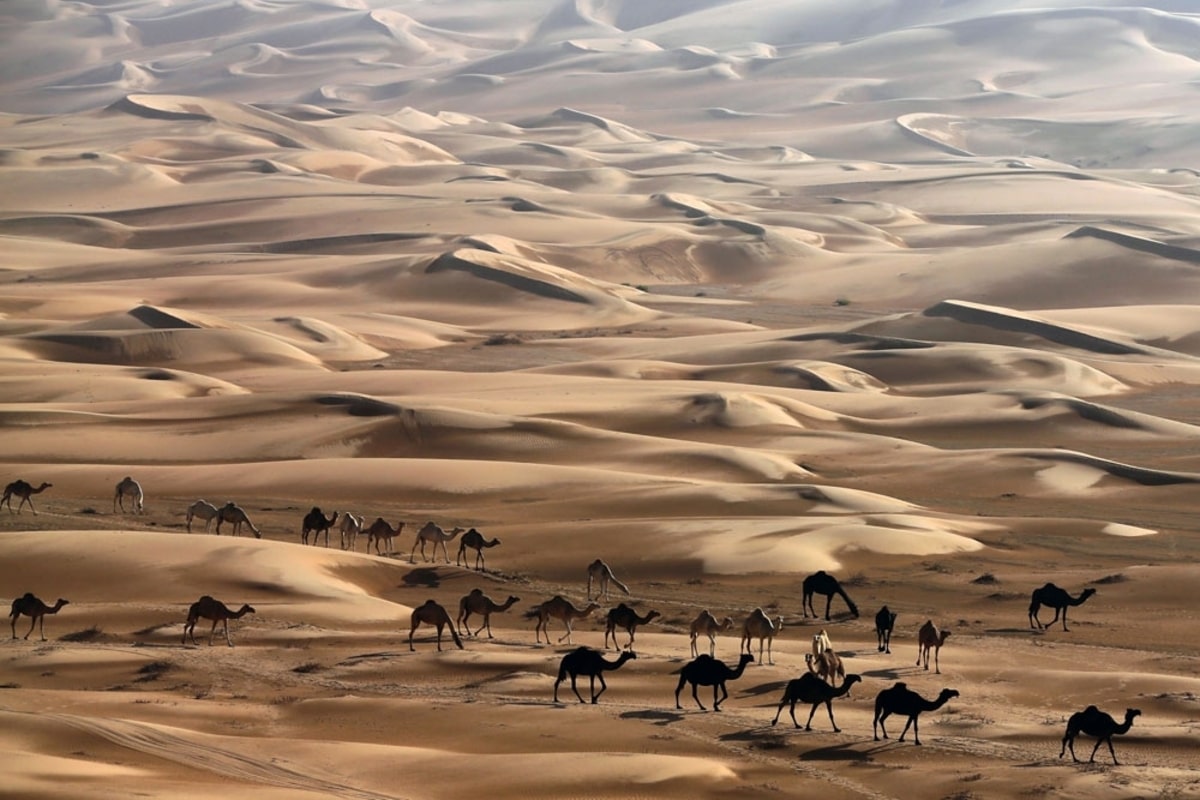The Rub’ al Khali is one of the most mysterious and awe-inspiring deserts in the world, covering a vast portion of the Arabian Peninsula. Its endless dunes, harsh climate and near-total absence of permanent life make it a unique and formidable natural wonder. This region is surrounded by legends, mentioned in historical texts and continues to attract the curiosity of explorers, geologists and adventurers. In this article, you will discover interesting facts about the Rub’ al Khali that you may not have known before.
- The name Rub’ al Khali translates to “Empty Quarter” and accurately reflects the nature of this place. It is one of the largest sand deserts on the planet, stretching approximately 1,000 kilometers in length and 500 kilometers in width. It spans across parts of Saudi Arabia, Oman, Yemen and the United Arab Emirates.
- The total area of the Rub’ al Khali is about 650,000 square kilometers, which is roughly equivalent to the size of France. The desert is composed mainly of giant sand dunes, some of which can exceed 250 meters in height. This makes it the largest continuous sand desert in the world.
- The climate in the Rub’ al Khali is extremely harsh, with average summer temperatures often exceeding 50 degrees Celsius. Rainfall is incredibly rare and may not occur for several years at a time. As a result, there are almost no surface water sources, and plant and animal life is highly limited.
- Despite the arid surface, the desert contains underground reserves of fresh water that date back to wetter climatic periods. In some areas, water can still be found in artesian aquifers or natural depressions. These hidden sources have been vital for the survival of nomadic tribes.
- The Rub’ al Khali holds significant historical value in Arab culture. Ancient trade routes once crossed this region, carrying incense, spices and valuable goods. Archaeological discoveries of caravanserais and ancient settlements confirm the desert’s past as a corridor of commerce.
- One of the most famous explorers of the Rub’ al Khali was British adventurer Wilfred Thesiger, who crossed the desert in the mid-20th century. His expedition, documented in the book Arabian Sands, became a classic account of survival and cultural exploration. His journals offer deep insights into Bedouin traditions and desert geography.
- The landscape of the Rub’ al Khali constantly changes due to strong winds that reshape sand dunes and shift the terrain. This makes navigation and mapping particularly difficult. Even today, some parts of the desert remain largely unexplored.
- Beneath the sands lie significant reserves of oil and natural gas. Extraction is carried out using advanced infrastructure that operates under extreme heat and frequent sandstorms. The Rub’ al Khali plays a vital role in the energy sector of Saudi Arabia.
- The desert’s fauna consists mainly of nocturnal animals adapted to extreme conditions. Among them are desert foxes, lizards, scorpions and various species of snakes. These creatures have evolved special mechanisms for conserving water and avoiding overheating.
- The vegetation in the Rub’ al Khali is limited to drought-resistant plants such as saxaul, ephemeral species and camel thorn. These plants grow sparsely but play an important role in maintaining the fragile ecosystem. Their roots help stabilize the sand and prevent erosion.
- Some dunes in the desert have a reddish or orange hue due to the presence of iron oxides in the sand. This gives the landscape a striking appearance, especially at sunrise or sunset. These views attract photographers and nature enthusiasts from around the world.
- For many years, the Rub’ al Khali was considered completely impassable and was often called the “forbidden zone.” Crossing it required meticulous planning, large water supplies, camels and deep knowledge of the terrain. Even today, despite modern technology, traveling across the desert remains a challenging endeavor.
- Underneath the sand, scientists have discovered traces of ancient river systems, indicating that the area once had a wetter climate. Fossils, sediment layers and ancient shorelines provide evidence of this climatic history. Such findings are valuable for reconstructing the environmental past of the region.
- The Rub’ al Khali is of special interest to adventurers, documentarians and climate researchers. Expeditions often face technical difficulties and natural dangers, but the data collected is vital for studying desertification and global climate change. The desert serves as a natural laboratory for scientific inquiry.
These fascinating facts about the Rub’ al Khali reveal that this desert is far more than a barren sea of sand. It is a complex, dynamic natural system with deep historical roots and significant modern relevance. It unites ancient trade networks with today’s scientific challenges and discoveries. These incredible facts may inspire you to learn more about desert ecosystems and the natural wonders of the Middle East.





